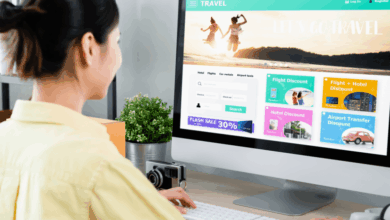Smart Travel Safety Tech Revolutionizes Journeys

Introduction: The New Era of Protected Exploration
In an increasingly interconnected world where travel has rebounded with unprecedented vigor, a parallel revolution is quietly transforming how we secure our journeys. Travel safety technology, once limited to simple luggage locks and hotel safes, has evolved into a sophisticated ecosystem of intelligent devices and digital platforms that protect travelers from countless potential risks. This technological renaissance addresses modern concerns ranging from health emergencies and natural disasters to digital theft and physical security, fundamentally reshaping the travel experience. As both frequent flyers and occasional tourists navigate post-pandemic landscapes and complex digital environments, these innovations provide crucial layers of protection that enable more confident exploration. This comprehensive examination explores the cutting-edge advancements securing every aspect of contemporary travel, from AI-powered threat detection to biometric identification systems that are gradually making passports obsolete.
A. Health and Medical Safety: Technological Guardians of Wellbeing
The global health crisis accelerated innovation in travel medical technology, resulting in solutions that now provide continuous protection for travelers worldwide.
A.1. Next-Generation Health Monitoring Wearables
Modern travel wellness technology extends far beyond basic fitness trackers, incorporating specialized features designed specifically for mobile populations.
-
Advanced Biometric Sensors: Contemporary devices now monitor blood oxygen saturation, stress levels through heart rate variability, and even early signs of altitude sickness, providing warnings before conditions become serious.
-
Environmental Risk Detection: Several cutting-edge wearables now measure air quality, UV exposure levels, and pollen counts, alerting sensitive travelers to potential environmental hazards at their destination.
-
Emergency SOS Features: Integrated cellular and satellite connectivity enables automatic fall detection and emergency alert systems that transmit location data to predetermined contacts and local emergency services, even in remote areas.
A.2. Telemedicine Platforms for Global Healthcare Access
The proliferation of dedicated travel medicine platforms has democratized access to quality healthcare across geographical boundaries.
-
24/7 Virtual Consultations: These services connect travelers with licensed physicians within minutes, overcoming language barriers through integrated translation services and local provider networks.
-
Digital Prescription Services: Approved medications can be electronically prescribed to local pharmacies at the traveler’s destination, eliminating the stress of lost medications or unexpected medical needs.
-
Medical Record Portability: Secure, blockchain-based systems enable travelers to carry encrypted, accessible health records that can be shared with foreign medical facilities during emergencies, ensuring continuity of care.
A.3. AI-Powered Health Risk Assessment Tools
Sophisticated algorithms now provide personalized health guidance based on multiple data points.
-
Destination-Specific Health Intelligence: These platforms analyze real-time disease outbreaks, vaccination requirements, and local healthcare quality to provide customized recommendations for each itinerary.
-
Symptom Checker Integration: AI-driven assessment tools help travelers distinguish between common travel illnesses and more serious conditions, recommending appropriate action from self-care to immediate medical attention.
B. Physical Security Innovations: Protecting People and Possessions
Traditional travel security concerns have been addressed with increasingly intelligent solutions that proactively prevent incidents rather than merely responding to them.
B.1. Smart Luggage and Asset Protection Systems
The humble suitcase has transformed into a connected security device through integrated technologies.
-
GPS Tracking and Geofencing: Modern tracking tags and smart luggage create virtual boundaries around possessions, sending immediate alerts if items move beyond predetermined areas, significantly reducing luggage loss and theft.
-
Biometric Access Systems: Fingerprint and facial recognition locks have replaced easily-picked traditional locks, while some advanced models feature tamper-proof mechanisms that automatically notify owners of unauthorized access attempts.
-
Digital Inventory Management: RFID technology and smartphone applications enable travelers to maintain real-time inventories of their belongings, providing crucial documentation for insurance claims when losses occur.
B.2. Personal Safety Devices and Applications
A new category of compact, powerful safety tools provides individual protection through connected technology.
-
Discreet Emergency Alert Systems: Modern personal safety devices masquerade as everyday items like keychains or jewelry while featuring one-touch alert systems that notify emergency contacts and share live location data during threatening situations.
-
Location Sharing and Check-In Services: Smart applications enable automated location sharing with trusted networks, with missed check-in alerts triggering welfare verification protocols.
-
Audio and Video Documentation Tools: Several safety applications feature discreet recording capabilities that automatically upload footage to cloud storage, creating valuable evidence during incidents while ensuring data preservation even if the device is damaged or seized.
B.3. AI-Enhanced Accommodation Security
Technology has significantly improved safety in temporary accommodations through both brought and built-in solutions.
-
Portable Security Systems: Travel-friendly door alarms, window sensors, and portable motion detectors create instant security perimeters in any accommodation, with several models featuring cellular connectivity for remote monitoring.
-
Privacy Protection Devices: RF signal detectors identify hidden cameras, while specialized covers block laptop webcams and microphones against digital intrusion, addressing growing concerns about accommodation-based surveillance.
-
Safety Verification Platforms: Digital services now aggregate safety data for accommodations, combining crime statistics, guest reviews, and infrastructure assessments into comprehensive safety scores that inform booking decisions.
C. Digital Security and Information Protection
As travel becomes increasingly connected, protecting digital assets and personal information has emerged as a critical component of comprehensive travel safety.
C.1. Secure Connectivity Solutions
Public network vulnerabilities have spurred development of robust protection technologies for traveling professionals and casual tourists alike.
-
Travel-Specific VPN Services: Unlike standard VPNs, travel-optimized virtual private networks feature specialized servers for streaming and banking, while providing enhanced protection against public Wi-Fi risks prevalent in airports, hotels, and cafes.
-
Portable Privacy Routers: These compact devices create personal Wi-Fi networks from wired connections or cellular data, preventing direct connection to potentially compromised public networks while allowing multiple devices to share a single secure connection.
-
Privacy-Focused Browsers: Several applications now offer built-in tracker blocking, fingerprint masking, and automatic HTTPS redirection to protect search history and online activities from surveillance, especially important in countries with restricted internet freedom.
C.2. Financial and Identity Protection Technologies
Modern solutions significantly reduce the risk of financial fraud and identity theft during travel.
-
Digital Payment Security: RFID-blocking wallets and sleeves protect contactless cards from electronic pickpocketing, while mobile payment systems offer tokenization that never shares actual card details with merchants.
-
Document Protection and Management: Secure digital vaults with military-grade encryption enable travelers to store scanned copies of crucial documents like passports and visas, accessible through multi-factor authentication even if primary devices are lost or stolen.
-
Identity Monitoring Services: Specialized travel protection platforms monitor dark web activity for compromised personal information, providing early warnings about potential identity theft targeting travelers.
D. Transportation and Navigation Safety
Technological advancements have dramatically improved safety across all transportation modes, from airport approaches to final destination navigation.
D.1. Intelligent Transportation Security Systems
Modern transportation integrates multiple technologies to protect travelers throughout their journeys.
-
Ride-Verification Platforms: Beyond basic ride-sharing, advanced services now provide driver verification, automated route tracking with deviation alerts, and emergency response integration, significantly improving ground transportation safety.
-
Real-Time Transit Safety Monitoring: Public transportation applications now incorporate crime data, crowd density information, and facility safety ratings to help travelers make informed decisions about routes and timing.
-
Vehicle Safety Integration: Rental car companies increasingly feature connected vehicle technology that automatically detects accidents, monitors maintenance issues, and provides emergency services coordination, adding crucial protection layers for drivers in unfamiliar territories.
D.2. Advanced Navigation and Situational Awareness Tools
Location technology has evolved far beyond basic mapping to provide comprehensive environmental intelligence.
-
Safety-Focused Routing Algorithms: Modern navigation applications process real-time crime statistics, accident data, and even weather conditions to suggest routes that optimize for safety alongside efficiency, avoiding high-risk areas especially during nighttime travel.
-
Augmented Reality Wayfinding: Emerging AR navigation systems overlay directional information onto real-world views through smartphone cameras, reducing the disorientation and vulnerability that often accompanies constant map-checking in unfamiliar environments.
-
Offline Map Intelligence: Sophisticated mapping applications now download comprehensive destination data including emergency service locations, medical facilities, and safe zones for access without cellular connectivity, crucial for international travel or remote exploration.
E. Crisis Response and Emergency Technologies
When prevention fails, advanced technologies provide crucial response capabilities that can significantly improve outcomes during travel emergencies.
E.1. Integrated Emergency Communication Systems
Modern solutions ensure reliable communication when traditional systems fail or prove inadequate.
-
Multi-Network Communication Devices: Specialized travel phones and accessories automatically switch between cellular, satellite, and Wi-Fi networks to maintain connectivity in areas with spotty coverage or during network congestion following disasters.
-
Translation-Enabled Emergency Services: Next-generation safety applications connect travelers with emergency operators who can automatically translate situations to local responders, overcoming critical language barriers during high-stress emergencies.
-
Automated Emergency Notification Systems: Corporate and academic travel platforms now feature mass notification capabilities that instantly alert travelers about natural disasters, civil unrest, or other emergencies at their locations, with integrated response guidance.
E.2. Disaster and Crisis Management Tools
Specialized technologies help travelers navigate large-scale emergencies through preparation and real-time intelligence.
-
Global Alert Integration: Comprehensive travel safety applications aggregate alerts from government sources, weather services, and security providers to deliver prioritized notifications about developing situations.
-
Evacuation Planning and Coordination: Several premium security services provide personalized evacuation planning, including transportation coordination and destination assistance during political instability or natural disasters.
-
Crisis Resource Locators: During widespread emergencies, specialized platforms map available resources like open hospitals, functional ATMs, and operational transportation hubs, creating crucial intelligence when local systems are overwhelmed.
Conclusion: The Future of Travel Safety Technology
The rapid evolution of travel safety technology represents a fundamental shift from reactive protection to proactive prevention, with intelligent systems increasingly predicting and mitigating risks before they materialize into threats. As artificial intelligence, biometrics, and connectivity continue advancing, we approach a future where comprehensive protection becomes seamlessly integrated into every journey stage—from initial planning to final return. This technological empowerment doesn’t eliminate travel risks but substantially equalizes the balance between travelers and potential hazards, enabling more confident exploration of both popular destinations and remote frontiers. The ultimate destination for travel safety technology is complete invisibility—protection so seamlessly integrated into our journeys that it becomes an unconscious guardian, allowing travelers to focus on the enrichment of discovery rather than the fear of potential dangers. In this not-too-distant future, the greatest travel safety technology will be the protection we never notice until the moment we need it most.
Tags: travel safety technology, smart travel gear, biometric security, travel health tech, digital nomad safety, emergency communication devices, travel apps, luggage tracking, personal safety devices, travel insurance tech, hotel security, transportation safety






